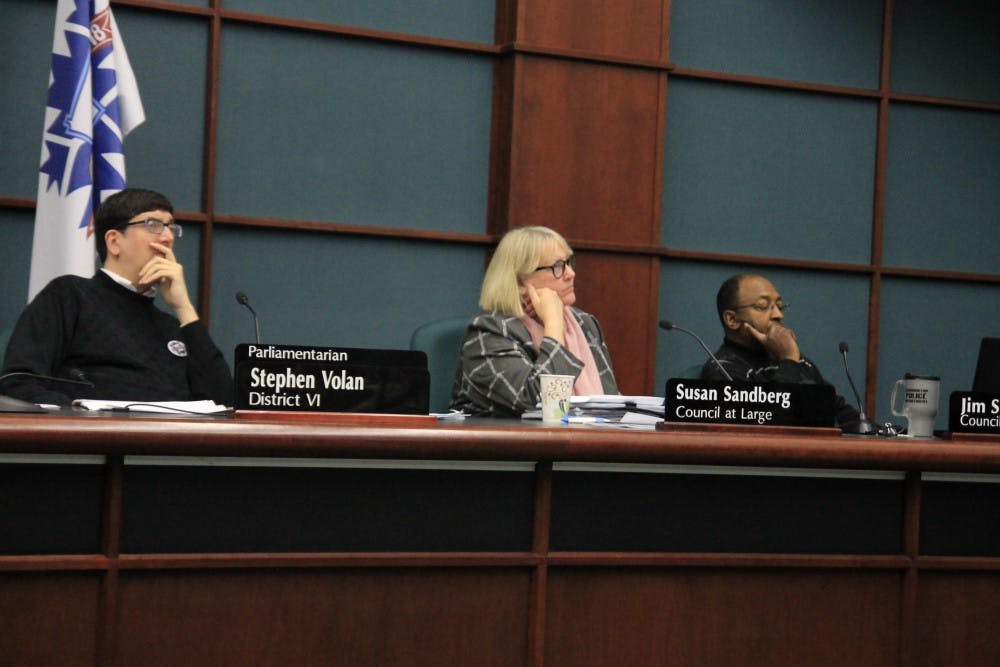The Bloomington City Council voted unanimously Wednesday to adopt the city’s Comprehensive Plan.
This plan is designed to help improve Bloomington through the year 2040 by providing set goals for the city.
Although the council meeting ran until about 11 p.m. as members debated final amendments, the approval vote renewed some of the energy in the room.
Council members Dave Rollo and Jim Sims high-fived.
Instead of yes, council member Steve Volan voted with an “Amen.”
During the amendment process earlier in the meeting, the council addressed expanded writing on quality of life, growth and housing in Bloomington.
Quality of Life
Multiple amendments focused on how to address life for Bloomington residents. They expanded the way the plan should measure change in the community.
Council member Andy Ruff proposed an updated vision statement of Bloomington’s growth through 2040. The statement said the plan would need to consider measuring the city’s quality of growth as well as quantity of growth to indicate success.
The amendment noted that an original resolution, passed in 2013, did not fully define the plan’s intentions.
The new suggestion encompassed societal benefits, such as education, civic engagement, and Bloomington’s role as a regional economic hub, to measure success.
Rollo said he particularly liked that the vision statement addressed Bloomington’s economic importance because it could help nearby towns improve in the future.
“I think it’s good to consider other communities as well and do what we can to enhance their independence as economic hubs in their own right,” Rollo said.
Rollo introduced the addition of a Quality of Life Survey, which will help the city assess how its citizens fare over time.
After a suggestion from Chris Sturbaum, the Quality of Life Survey amendment was once again tweaked to make it clear that this assessment would happen more than once.
“We don’t want this to be interpreted as a one-off,” Rollo said. “We want to have it be recurring.”
Another amendment from Vice President Isabel Piedmont-Smith clarified an amendment in the plan that intends to move Bloomington toward developing as a Lifetime Community.
“The Lifetime Community concept is part of the international effort to make cities more livable by emphasizing quality of life for people of all ages, abilities and socioeconomic backgrounds,” according to the amendment.
Piedmont-Smith said this amendment was particularly important for senior citizens. In addition, the Bloomington Commission on Aging has separately been planning to create an area along the B-Line trail that provides senior citizens with easy access to many of the city’s amenities.
Susan Sandberg said she thought this would help people stay active in the community beyond retirement age.
“It looks like a great place that anybody would want to live, but again, particularly seniors don’t want to feel isolated,” Sandberg said.
These amendments all passed unanimously.
Anticipated growth
Bloomington is expected to have a population of more than 100,000 people by 2040, according to an amendment proposed by Sandberg and Volan.
The U.S. Census Bureau estimated that Bloomington had a population of 84,465 in 2016.
Using data from the American Community Survey and Envision Tomorrow's Balanced Housing Model, the amendment addressed how 12,225 housing units, either rental or owner-occupied, will need to be added to accommodate the growing population. About 2,610 more units will need to be renovated to stay up with housing codes.
IU students living off-campus were considered in the projected numbers, but those living in residence halls and greek housing were not included.
This amendment also passed unanimously.
Housing
The greatest conflicts were seen on amendments that addressed how housing growth in the city would be regulated.
An amendment from Rollo and Piedmont-Smith specified that new buildings would have to follow neighborhood architecture in areas with specific character and design.
Despite concern that this would discourage new buildings entirely, Piedmont-Smith emphasized that the amendment allowed for modern design as long as it still matched the area.
The amendment passed in a 5-3-1 vote, with Volan, Sims and Ruff voting no and a pass from Chopra.
In a 7-1-1 vote, projects in the Urban Corridor district will be allowed as many as four stories, continuing the trend of building housing units upward rather than outward.
“Density has to go somewhere,” Piedmont-Smith said.
Volan abstained from the vote, but he debated against it because of criticism of the high-density area around Walnut Street and College Avenue.
In the past, he endorsed Smallwood Plaza, a controversially tall development on North College Avenue, as a density project, but said he now thinks it was built too high.
He also said the council members’ acceptance of building density may not match the wants of most Bloomington community members.
“I’m warning you now, we’re gonna hear from people about this amendment,” Volan said.
Chopra voted no, but said it was because she disagreed with the amendment's phrasing, not necessarily its content.
She said her main concern wasn’t with the height of the buildings but that new additions not be ugly.
Building density itself is not the problem, Chopra said. She prefers constructing buildings taller over spreading further out in order to avoid turning Bloomington into a city with spread-out suburban neighborhoods.
“We are a compact community, and that’s something I want to see moving forward,” Chopra said.




